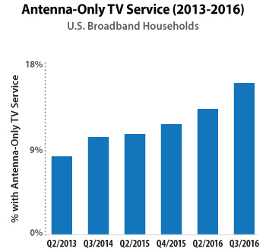Report: Antenna Only Homes Increase to 15 Percent
DALLAS—While we’re certainly no longer in the days where people had a pair of rabbit ears on top of their TV sets, the use of antennas are making a little bit of a comeback according to a recent report from Parks Associates. As a result of the cord-cutting trend and the decline of pay-TV subscriptions, the “360 View: Entertainment Services in U.S. Broadband Households” report shows there has been an increase in antenna-only homes to a total of 15 percent.

The number of antenna-only homes has been on the rise since Q3 2013 while pay-TV subscriptions have dropped each year since 2014; pay-TV subscriptions sat at 81 percent as of Q3 2016. Since Q3 2013, the number of homes that only use an antenna for their TV service has nearly doubled.
However, the reemergence of antennas is not the only factor affected or influencing the decline of pay-TV subscriptions. OTT service continues to be a major factor in the decline of pay-TV services. According to Parks Associates’ “OTT Video Market Tracker,” 63 percent of U.S. broadband households subscribe to at least one OTT service, while 31 percent subscribe to multiple.
Additional findings from the recent “360 View” report include how twice as many subscribers (12 percent) downgraded their pay-TV service to those who upgraded (6 percent); the likelihood of non-subscribers adopting pay-TV has declinded since 2012; only 2 percent of those classified as “Cord Nevers” signed up for pay-TV in 2016, down from 4 percent in 2015; in addition, the size of the Cord Never contingent is increasing.
“With the continued decline of traditional pay-TV subscriptions, 2017 will be characterized by the rise of online pay-TV services,” said Brett Sappington, senior director of research for Parks Associates. “While traditional pay TV provides superior viewing quality, OTT video commonly excels in discovery, portability, and personalized user experiences. Consumers care less about the network used to deliver the content than they do about access to the content, ease of use, and convenience.”
For more information, read the full “360 View: Entertainment Services in U.S. Broadband Households” report.
The professional video industry's #1 source for news, trends and product and tech information. Sign up below.
